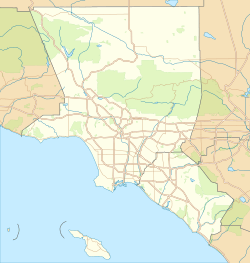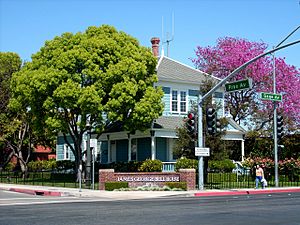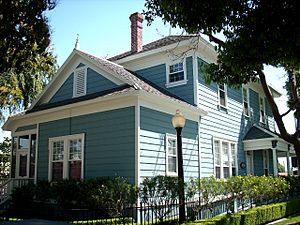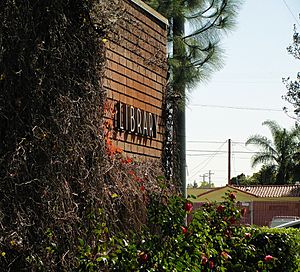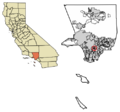Bell, California facts for kids
Quick facts for kids
Bell, California
|
|||
|---|---|---|---|
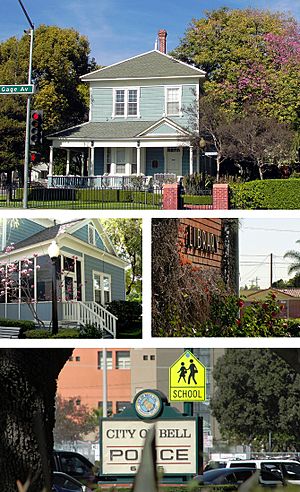
Images, from top and left to right: James George Bell House, Bell Public Library, City of Bell Police sign
|
|||
|
|||

Location of Bell in Los Angeles County, California.
|
|||
| Country | |||
| State | |||
| County | Los Angeles | ||
| Incorporated | November 7, 1927 | ||
| Named for | The family of James George Bell | ||
| Area | |||
| • Total | 2.63 sq mi (6.80 km2) | ||
| • Land | 2.51 sq mi (6.50 km2) | ||
| • Water | 0.12 sq mi (0.31 km2) 4.53% | ||
| Elevation | 141 ft (43 m) | ||
| Population
(2020)
|
|||
| • Total | 33,559 | ||
| • Density | 13,380.78/sq mi (5,166.23/km2) | ||
| Time zone | UTC-8 (PST) | ||
| • Summer (DST) | UTC-7 (PDT) | ||
| ZIP Code |
90201, 90202, 90270
|
||
| Area code(s) | 323 | ||
| FIPS code | 06-04870 | ||
| GNIS feature IDs | 1660322, 2409816 | ||
Bell is a city in Los Angeles County, California. It is located near the Los Angeles River. Bell is also a suburb of the larger city of Los Angeles.
In 2010, about 35,477 people lived in Bell. It is one of the smallest cities in the United States. It has a population of at least 25,000 people.
In 2005, Bell became a "charter city." This meant city officials could set their own salaries. Later, it was discovered that some officials were paying themselves very high salaries. This led to a big public issue, and these officials were removed from their jobs.
Contents
History of Bell
Early Beginnings
The area where Bell is now located has a long history. Native American people called the Gabrieliño Indians lived here thousands of years ago. They arrived around 500 B.C.
Spanish settlers came to this part of California in the mid-1700s. One of the first families was the Lugos. Antonio María Lugo was born in 1775. He became a Spanish soldier and aristocrat.
In 1810, the King of Spain gave Lugo 30,000 acres of land. This land included the area of present-day Bell. It was known as Rancho San Antonio.
By 1865, the Lugo family had lost much of their wealth. Most of the Rancho was sold for a very low price. The Lugo family kept their home, built around 1810. It is now the oldest house in Los Angeles County.
Between 1870 and 1890, new settlers arrived. One important family was James George Bell and his wife, Susan Abia Hollenbeck Bell. They moved to the area in 1876.
The Bell family acquired about 360 acres of land. They helped develop the area into a small farming community. The Bell family lived in their "ranch" house, now a historic landmark. It is called the Bell House.
In 2000, the Bell House was named a California State Historical Resource. In 1898, the town's name changed from Rancho San Antonio to Bell. This was to honor its founders.
Between 1920 and 1935, Bell's population grew very quickly. New businesses and schools were built. Community groups like the Bell Chamber of Commerce were started.
In 1924, George O. Wheeler started the local newspaper, the Industrial Post. It later became the Community News. This newspaper eventually disappeared.
In 1925, the Alcazar Theater opened to show "talking pictures." It has since been taken down. Also in 1925, Bell High School opened its doors.
Becoming a City
Bell officially became a city in 1927. Since then, the city has added public parks. It also started recreational programs for its residents.
The city built a good sewer system. It also made major streets wider. A city hall was built. Fire department buildings were also provided.
The city of Bell worked with Maywood and Los Angeles County. Together, they built an indoor public swimming pool. This pool is located at Bell High School.
Bell's Chamber of Commerce is in the historic James George Bell House. This house is a meeting place and a museum. It shows items from the city's founding family. The house is open to everyone for free.
In 2007, Bell had its first city council election in almost ten years. The next election was in 2011. In that election, most city council members were removed from office.
Geography of Bell
Bell is a small city. According to the United States Census Bureau, it covers about 2.6 square miles (6.8 square kilometers). Most of this area is land. A small part is water.
People of Bell
| Historical population | |||
|---|---|---|---|
| Census | Pop. | %± | |
| 1930 | 7,884 | — | |
| 1940 | 11,264 | 42.9% | |
| 1950 | 15,430 | 37.0% | |
| 1960 | 19,450 | 26.1% | |
| 1970 | 21,836 | 12.3% | |
| 1980 | 25,450 | 16.6% | |
| 1990 | 34,365 | 35.0% | |
| 2000 | 36,664 | 6.7% | |
| 2010 | 35,477 | −3.2% | |
| 2020 | 33,559 | −5.4% | |
| U.S. Decennial Census | |||
Bell's Population in 2010
The 2010 United States Census showed that Bell had 35,477 residents. The city was quite crowded, with many people living in a small area.
Most people in Bell were of Hispanic or Latino background. They made up about 93.1% of the population. Other groups included White, African American, Native American, and Asian people.
Most people lived in homes with their families. About 98.4% of the population lived in households. The average household had about 3.93 people. Many households had children under 18.
The median age in Bell was 28.9 years old. This means half the people were younger than 28.9, and half were older. About 32% of the population was under 18.
Bell's Population in 2000
In 2000, Bell had 36,664 people. The city was very diverse. About 90.9% of the population was Hispanic or Latino.
Many households had children under 18. The average household size was 4.05 people. The average family size was 4.27 people.
About 35.3% of the population was under 18 years old. The median age was 26 years.
The most common backgrounds were Mexican (67.7%) and Salvadoran (4.4%). Many residents were born in Mexico (73.1%) or El Salvador (9.8%).
Income in Bell
Between 2009 and 2013, the average household income in Bell was $35,985. About 30.2% of the residents lived below the federal poverty line.
Economy of Bell
Bell is currently facing financial challenges. This is due to the public issues mentioned earlier. Former city officials misused tax money. This has caused a shortage of several million dollars in the city's budget.
An audit by Los Angeles County suggested changes. The city might need to reduce its spending. This could include possibly closing its police department. The county sheriff's department might then take over policing duties.
Education in Bell
Schools in Bell
Bell is part of the Los Angeles Unified School District (LAUSD). Some parts of Bell are also within the Montebello Unified School District.
Public Schools
Kindergarten schools:
- Martha Escutia Primary Center (opened in 2005)
Elementary schools:
- Corona Avenue Elementary School (Grades K-5)
- Nueva Vista Elementary School (Grades K-5)
- Woodlawn Avenue Elementary School (Grades K-5)
- Ellen Ochoa Learning Center (Grades K-5)
Middle schools:
- Chester W. Nimitz Middle School (Huntington Park)
- Orchard Academy Middle Schools
K-8 schools:
- Ellen Ochoa Learning Center (Cudahy)
High schools: All students living in Bell attend Bell High School. The high school has a diverse student body. Most students are Hispanic. There are also smaller groups of Black, Lebanese, Asian, and Pacific Islander students.
Bell High School's goal is to help all students learn and grow. They want students to become active members of society. The school mascot is the "Mighty Eagles."
Students in Bell or Huntington Park can also apply to Maywood Academy High School. This school opened in 2005.
Private Schools
Al-Hadi School is a private school located in Bell.
Public Libraries
The County of Los Angeles Public Library runs the Bell Library. It is located at 4411 East Gage Avenue.
Parks and Fun in Bell
The city of Bell has many places for recreation. The Bell Community Center is a popular spot. It hosts events like birthdays and parties.
Treder Park is at the community center. It has a gazebo and picnic areas. Camp Little Bear Park and Lodge is for children aged 12 and under. This park has basketball, handball, and four square courts. It also has an outdoor theater for movies. There's a miniature golf course and an indoor lodge with computers.
Ernest Debs Park has a soccer field with artificial grass. It also has an outdoor fitness area. The park has basketball courts, benches, and picnic tables.
Veterans Memorial Park has basketball courts and batting cages. It has a baseball field with stadium seating. There are also picnic tables, a playground, and a rose garden. The rose garden honors U.S. soldiers.
The city also works with the Los Angeles Unified School District. They use the Nueva Vista Elementary Soccer Field after school. This helps with youth and adult soccer programs. The Bell Futsal Park opened in 2018. It was once a skate park. Now it has a main court that can be split into three smaller courts.
Images for kids
See also
 In Spanish: Bell (California) para niños
In Spanish: Bell (California) para niños




